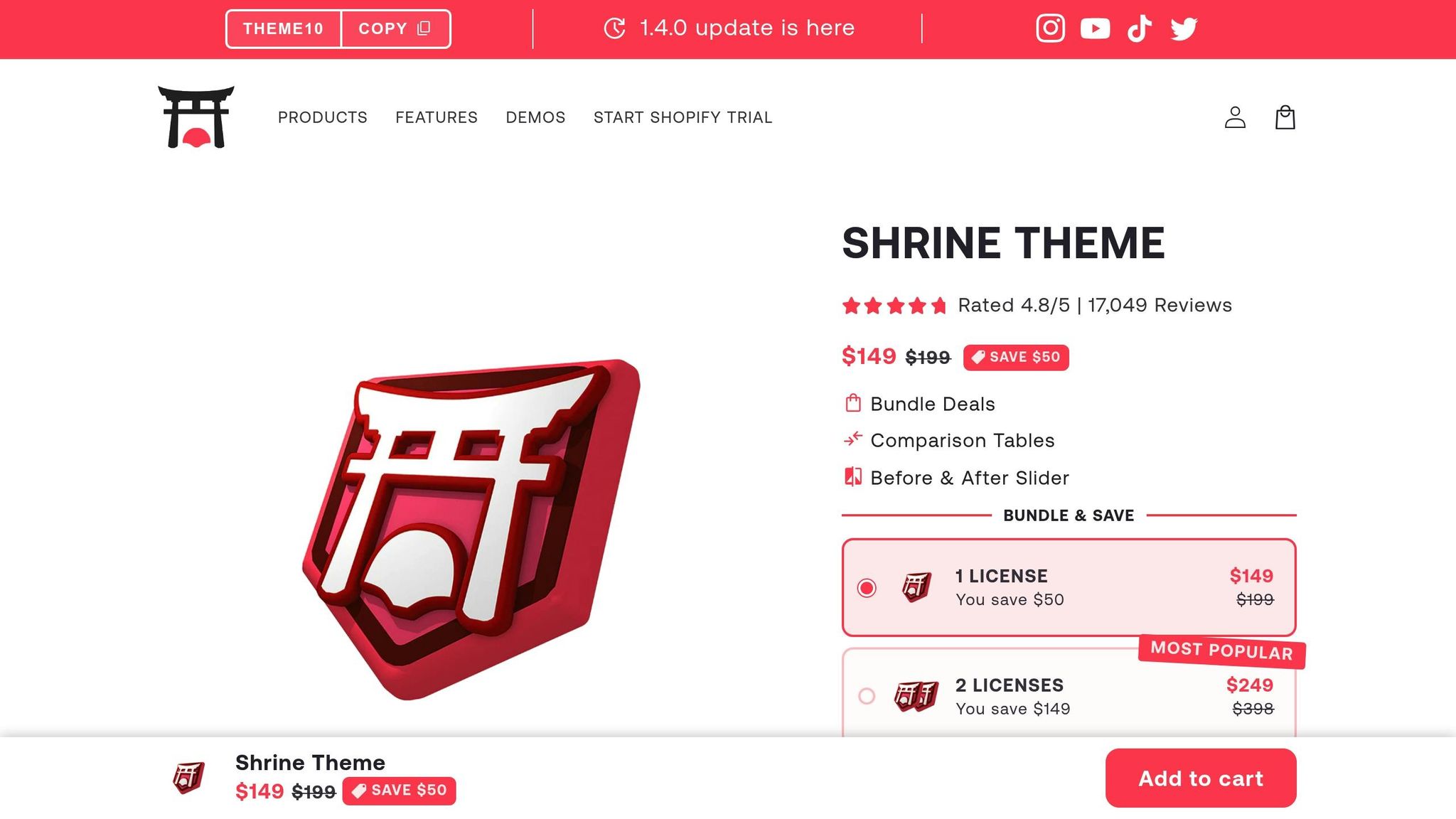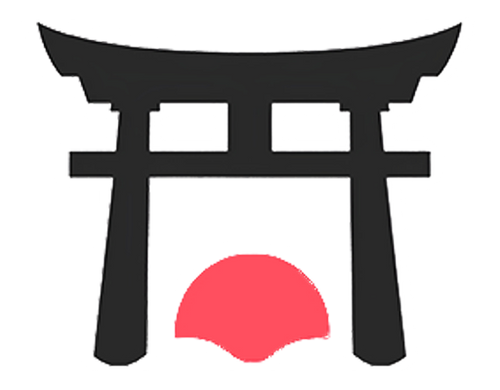Your Shopify theme is the foundation of your online store. Choosing the right one can directly impact sales, customer experience, and long-term growth. Here’s what you need to know upfront:
-
Match Your Theme With Your Business Model:
- Direct-to-Consumer (DTC): Focus on storytelling and visuals.
- Dropshipping: Prioritize speed and streamlined checkout.
- Digital Products: Highlight trust, clear pricing, and instant delivery.
- Luxury Brands: Use elegant designs and large images.
- High-Volume Retailers: Opt for advanced filtering and robust navigation.
-
Key Features to Look For:
- Built-in Sales Tools: Upsells, bundles, and trust badges.
- Performance: Fast loading speeds and mobile responsiveness.
- Customization: Flexible layouts and easy design tweaks.
- US Market Optimization: USD pricing, local shipping, and tax settings.
-
Top Recommendations:
- Shrine ($149): Best for small and growing stores.
- Shrine Pro ($349): Ideal for large or high-traffic stores with advanced needs.
Quick Comparison
| Feature Category | Shrine | Shrine Pro |
|---|---|---|
| Total Features | 74 | 128 |
| Product Info Blocks | 22 | 34 |
| Customizable Sections | 33 | 44 |
| Cart Tools | 6 | 20 |
| Price | $149 | $349 |
Pro Tip: Start with Shrine and upgrade to Shrine Pro as your store grows. Both themes are fast, mobile-friendly, and designed to save costs by reducing the need for extra apps.
Choosing the right theme ensures your store meets customer expectations and supports your growth goals. Let’s dive into the details to help you make the best decision.
Understanding Your Business Model and Theme Requirements
Identifying Your Business Model
Your business model shapes how customers discover your store, navigate through it, and ultimately make purchases. Each type of business has distinct needs when it comes to theme features and design.
Direct-to-consumer (DTC) brands thrive on building deep connections with their audience. These businesses rely on storytelling and visually rich content to communicate their brand values. Themes that emphasize emotional engagement, detailed product descriptions, and premium visuals are essential.
Dropshipping stores prioritize speed and efficiency. With a focus on quick conversions, they benefit from themes that feature tools like quick view options, stock counters, and streamlined checkout processes to help customers move effortlessly from browsing to buying.
Digital product sellers have unique challenges since they sell intangible items like software, courses, or downloadable content. Their themes should highlight features like clear pricing, instant delivery messaging, and trust-building elements, ensuring customers feel confident in their purchase.
Luxury brands need themes that exude elegance and exclusivity. Everything from typography to layout should reflect sophistication, with minimal design clutter and larger product images to reinforce the premium nature of their offerings. These elements help justify higher price points.
High-volume retailers handle extensive product catalogs, which demand efficient organization. Themes with advanced filtering, powerful search tools, and well-structured category layouts ensure customers can quickly find what they’re looking for, even when browsing hundreds or thousands of items.
Take SilkSilky, for example. By upgrading to Shopify Plus, they achieved an impressive 680% sales growth over two years.
Once you’ve identified your business model, align these theme features with what US shoppers expect.
Key Factors to Consider for US Audiences
US customers have specific preferences that your theme needs to address. Ensure prices are displayed in USD (e.g., $19.99), dates follow the MM/DD/YYYY format, and major US payment methods are supported.
For stores with large inventories, prioritize themes offering expansive product images, detailed descriptions, and advanced filtering and search capabilities. Mapping out your customer journey can help identify critical features, such as multiple image views, easy access to customer support, or detailed product descriptions. Considering that 94% of first impressions are design-related, investing in a visually appealing and functional theme is essential.
Your growth strategy also plays a role in theme selection. Start-ups may focus on cost-effective and simple designs, while established brands often require themes that allow for advanced customization and scalability. Keep in mind that intuitive navigation can improve conversion rates by as much as 18.5%, making user-friendly design a vital component.
"Look for a design with the features you need most, then customize from there" – Shopify
US shoppers also expect fast, seamless interactions. With widespread access to high-speed internet, slow-loading websites can quickly frustrate users. Choosing a theme optimized for speed and responsiveness ensures smooth performance across all devices.
Since many Americans shop on their phones during commutes, lunch breaks, or evenings, your theme must excel on mobile just as much as it does on desktop. A great mobile experience is no longer optional - it’s a necessity.
Key Features to Look for in Shopify Themes

Picking the right Shopify theme is more than just an aesthetic choice - it’s about finding a theme packed with tools and optimizations that can boost engagement and conversions. For US shoppers, speed, clarity, and functionality are key, so a theme that balances these elements is essential.
Built-In Features That Drive Sales
A good theme should come equipped with tools that encourage larger purchases. Features like product upsells in the cart drawer, complementary product suggestions on product pages, and bundle deal sections can significantly increase your average order value. These built-in options also save you from adding extra apps, which could slow down your store’s performance.
Your cart is more than just a holding space - it’s a powerful conversion tool. Look for themes with features like discount code fields, free shipping progress bars, and trust badges. Advanced options such as countdown timers, conditional gift offers, and preselected upsells can further nudge customers toward completing their purchases.
Trust is crucial for US shoppers. Make sure your theme supports elements like payment badges, customer reviews, inventory status indicators, and estimated shipping times. These features help ease any doubts and build confidence during the buying process.
When it comes to showcasing products, dynamic product blocks are a game changer. Features like quantity breaks, variant pickers, sizing charts, and even emoji benefits make product pages more engaging. The ability to add custom fields, popup pages, and collapsible content ensures detailed product information is presented clearly without cluttering the page.
For visual storytelling, merchandising tools are invaluable. Features such as before-and-after sliders, comparison tables, shoppable images, and video integration (with MP4 upload support) allow you to highlight your products in creative ways. These tools are especially useful for brands that rely on compelling visuals to tell their story.
Once you’ve nailed down the sales tools, it’s time to focus on performance and flexibility.
Performance and Flexibility Requirements
Beyond features, your theme’s performance can make or break the customer experience. Speed is critical - a one-second delay in page load time can reduce conversions by 7%. Look for themes built with clean code, optimized images, and minimal resource loading. Use tools like Google PageSpeed Insights or GTmetrix to ensure your chosen theme meets high performance standards.
Mobile responsiveness is non-negotiable. With mobile devices driving a significant portion of eCommerce traffic, your theme must perform seamlessly across all screen sizes. Test its adaptability using tools like Chrome DevTools to ensure a smooth mobile experience.
SEO-friendly features should also be baked into the theme. Things like structured headings, schema markup, clean code architecture, and customizable meta tags are essential for improving search engine visibility. To confirm these features, use tools like Google’s Rich Results Test.
Finally, customization is key to keeping your store aligned with your evolving business needs. Look for themes offering adaptable page layouts, dynamic sections, and a wide range of design options. This flexibility allows you to tweak colors, fonts, layouts, and functionality without needing advanced coding skills. A strong section and block architecture also helps you create custom pages tailored to your brand.
By 2025, over 75% of eCommerce sales are expected to come from mobile devices.
Choosing a theme with the right mix of sales tools, performance optimizations, and customization options ensures your store not only meets but exceeds the expectations of US shoppers, whether you’re running a fast-paced dropshipping business or a high-end luxury brand.
Choosing Between Shrine and Shrine Pro

Now that we've outlined the performance and features of both themes, the choice between Shrine and Shrine Pro depends on your business's scale and requirements. Both options provide essential tools for sales and performance, but they cater to different levels of complexity and growth. Here's a detailed comparison to help you decide.
Feature Comparison: Shrine vs. Shrine Pro
The key difference between Shrine and Shrine Pro lies in the level of customization and advanced functionality they offer. While Shrine includes 74 features for $149, Shrine Pro steps it up with 128 features for $349, delivering a broader range of tools and capabilities.
Take Product Information Blocks, for example. Shrine offers 22 blocks covering essentials like variant pickers, product ratings, and urgency text. Shrine Pro expands this to 34 blocks, adding features like bundle offers, clickable discounts, product upsells, and Trustpilot integration.
When it comes to Customizable Sections, Shrine provides 33 options, including comparison tables, before-and-after sliders, and featured collections. Shrine Pro takes this further with 44 sections, introducing advanced elements like 3D parallax hero sections, shoppable images, Instagram stories integration, and Section Groups that offer over 1,900 unique layout combinations [38,39].
The cart drawer features highlight another major distinction. Shrine includes 6 basic tools, such as discount fields and progress bars. Shrine Pro goes beyond with 20 advanced tools, including countdown timers, conditional gifts, preselected upsells, and extensive customization options.
Additional tools round out the comparison. Shrine offers 13 tools, while Shrine Pro delivers 30, including features like 2,500 integrated icons, country blocking for international stores, megamenus, and advanced video players.
| Feature Category | Shrine | Shrine Pro |
|---|---|---|
| Total Features | 74 | 128 |
| Product Information Blocks | 22 | 34 |
| Customizable Sections | 33 | 44 |
| Cart Drawer Features | 6 | 20 |
| Additional Tools | 13 | 30 |
| Price | $149 | $349 |
Both themes are optimized for speed, loading 15–35% faster than the average Shopify theme. Shrine Pro's advanced optimizations are particularly well-suited for high-traffic stores [37,39].
Recommendations for Different Business Models
Here’s how the features align with different business needs:
- Shrine ($149): Ideal for smaller or growing stores. It’s a great starting point for dropshipping businesses, small direct-to-consumer brands, or digital product sellers. You’ll get professional tools without the added complexity or cost.
- Shrine Pro ($349): Perfect for enterprise-level stores, agencies managing multiple clients, or high-volume retailers focused on boosting conversions. With advanced cart tools and customization options, it’s especially beneficial for luxury brands or stores with complex product configurations. Additionally, the built-in features can replace costly app subscriptions, saving users over $150 per month [15,39].
"Shrine Pro Theme is hands down a must-have for any serious e-commerce store...Eliminates the need for many paid apps - I've easily saved over $1,000/year on subscriptions."
– badr-eddine Ouchhida, Shrine User
Agencies and developers will appreciate Shrine Pro's Section Groups feature, which enables over 1,900 design combinations, reducing development time while ensuring top-tier results. International businesses can benefit from the country blocker feature, which allows for regional content control - helpful for compliance and localized marketing. For luxury or high-end brands, the advanced visual elements, like 3D parallax sections and shoppable images, help maintain a premium shopping experience that attracts high-value customers.
If you start with Shrine and later decide you need the Pro features, the upgrade is simple - you only pay the $200 difference. Both themes have earned high customer satisfaction ratings, with Shrine receiving a 4.8/5 from 17,049 reviews and Shrine Pro achieving 4.7/5 from over 48,836 reviews [9,15].
Customizing Your Theme for US Stores
If you're running a Shopify store and targeting US customers, customizing your Shrine theme to meet their preferences can make a big difference. From pricing formats to design tweaks, aligning your store with local expectations helps build trust and can even boost conversion rates. For instance, something as simple as using the correct pricing format can significantly improve sales.
Setting Up for US Audiences
One of the first things to address is currency formatting. Head to your Shopify admin panel, navigate to Settings > General > Store currency, and select Change formatting. For US shoppers, set your base currency to USD and ensure the dollar sign appears before the number (e.g., $29.99 instead of 29.99$).
Shopify’s CLDR automatically formats content for US standards, but if you serve international customers too, you might want to display currency codes alongside prices. To do this, go to Online Store > Themes > Customize > Theme settings > Currency format and enable "Show currency codes". This will display prices as "USD $29.99" instead of just "$29.99".
Next, configure taxes and shipping based on US requirements. For taxes, consult state authorities, then go to Settings > Taxes and duties to add the states where you collect sales tax and input your sales tax ID. For shipping, set up zones under Settings > Shipping and delivery, and choose flat, weight-based, or carrier-calculated rates for US regions. If you operate in states like California, Colorado, or Florida, check whether shipping charges are taxable based on local laws.
Using Shrine's Built-In Customization Tools
Shrine themes come packed with tools to help you tailor your store to US customers, enhancing both the shopping experience and your conversion rates.
Visual branding is an important starting point. Upload your logo via Theme settings > Logo, and adjust your store’s color scheme under Theme settings > Colors to match your brand identity.
Typography customization is another way to create a consistent brand voice. Go to Theme settings > Typography to select fonts and sizes that appeal to your target audience.
When it comes to product pages, Shrine offers features designed to appeal to value-conscious US shoppers. For example, you can use bundle deals to encourage customers to buy more. Another option is quantity breaks, which offer discounts for bulk purchases directly on the product page. To help customers make decisions, utilize the before & after slider to showcase product transformations or comparison tables to highlight key features.
In the cart section, you can add upsell offers using Shrine’s cart upsells feature. Additionally, cart trust & urgency blocks allow you to include secure payment badges, countdown timers, and free shipping indicators, which can help nudge customers toward completing their purchases.
For mobile shoppers, you can upload engaging video content directly to your store using Shrine’s MP4 upload feature. You can also use the text with icon tool to present product benefits in a visually appealing, easy-to-scan format.
Shrine also gives you advanced layout control. Under Theme settings > Layout, you can adjust the maximum width of your store and tweak vertical and horizontal spacing to create a clean, organized design. For more specific design adjustments, both Shrine and Shrine Pro include custom CSS options under Theme settings > Custom CSS, allowing you to make changes without affecting the theme’s core functionality.
Social proof integration is key for US markets, where customer reviews heavily influence buying decisions. Shrine themes include built-in review and rating systems, and Shrine Pro even supports Trustpilot integration. You can also link your social media accounts through Theme settings > Social media, which will display in your store’s footer.
Finally, search customization under Theme settings > Search behavior ensures customers can quickly find what they need. You can also adjust cart style settings to match US shopping expectations, offering a seamless experience from product discovery to checkout.
Conclusion: Picking the Perfect Theme for Your Business
Selecting the right Shopify theme lays the groundwork for stronger conversions, customer trust, and steady growth. Whether you're running a direct-to-consumer brand, managing a dropshipping store, or selling digital products, your theme choice impacts everything from user experience to long-term success.
It's all about strategy. As Sahil Singh puts it, "When selecting a theme for your Shopify store, take a strategic approach by understanding your brand's needs, assessing your catalog size, and considering your customer journey". This means looking at how well a theme aligns with your brand, supports your catalog, enhances user experience, and performs on mobile devices - all while ensuring fast loading speeds. A thoughtful evaluation like this helps you balance features and costs effectively.
Performance should be a top priority. A one-second delay in load time can reduce conversions by 7%, and with mobile users driving most U.S. traffic, speed and responsiveness are critical. If you're scaling your business, consider themes like Shrine for essential features or Shrine Pro for advanced customization. Both offer a one-time payment model, saving you from ongoing subscription fees.
Over time, investing in Shrine or Shrine Pro can significantly cut costs by replacing the need for multiple paid apps. The numbers speak for themselves: Shrine has a 4.8/5 rating from over 17,000 reviews, while Shrine Pro boasts a 4.7/5 rating from more than 48,000 users. One satisfied user, badr-eddine Ouchhida, shared:
"Shrine Pro Theme is hands down a must-have for any serious e-commerce store...Eliminates the need for many paid apps - I've easily saved over $1,000/year on subscriptions".
Your theme choice influences every part of the customer experience - mobile responsiveness, SEO, payment processing, and even social proof integration. The right theme ensures a smooth journey from discovery to checkout. Focus on the features that directly support your business goals, and avoid getting sidetracked by unnecessary extras.
Ultimately, picking a theme like Shrine or Shrine Pro equips your store with the tools to excel. Whether you opt for Shrine's robust features or Shrine Pro's advanced capabilities, both provide the performance, flexibility, and built-in tools you need to stand out in today’s competitive e-commerce world.
FAQs
How can I choose the right Shopify theme for my business model?
Choosing the right Shopify theme hinges on your business model and specific needs. For direct-to-consumer (DTC) brands, opt for themes with a clean, visually striking design that puts your products in the spotlight. Luxury brands should lean toward refined, high-end designs that exude sophistication and class. If you're running a high-volume store or managing a complex brand, go for a flexible and highly customizable theme like Shrine Pro, which is well-suited for large inventories and detailed branding.
Make sure the theme you choose is responsive, quick to load, and simple to customize. It should not only match your brand's identity but also deliver a smooth shopping experience for your customers. Keep in mind both your current requirements and your long-term growth plans when making your decision.
What are the main differences between Shrine and Shrine Pro, and how do they affect my store’s performance?
Shrine is built for speed and efficiency, delivering quicker load times, smaller page sizes, and fewer HTTP requests. This makes it a solid choice for businesses looking to provide their customers with a seamless shopping experience.
On the other hand, Shrine Pro is crafted for larger stores and more intricate brands. It offers advanced features and greater customization options, making it a go-to for businesses with extensive product catalogs or specific operational requirements. While it has a slightly larger footprint, it’s designed to handle the challenges of growing businesses without sacrificing performance.
The decision between the two comes down to your store’s needs. Shrine works well for most businesses, while Shrine Pro is better suited for more complex or high-volume operations.
What customization features do Shrine themes offer to tailor my Shopify store for US customers?
Shrine themes offer a wide range of customization features, making it simple to design a Shopify store that connects with US shoppers. You can modify layouts, adjust color palettes, and choose typography that aligns with your brand’s style - all without needing to touch a single line of code.
What sets these themes apart is their performance. They load 15–35% faster than standard Shopify themes, ensuring a seamless shopping experience. This speed is crucial for meeting the high expectations of US customers, who prioritize convenience and quick site navigation.



